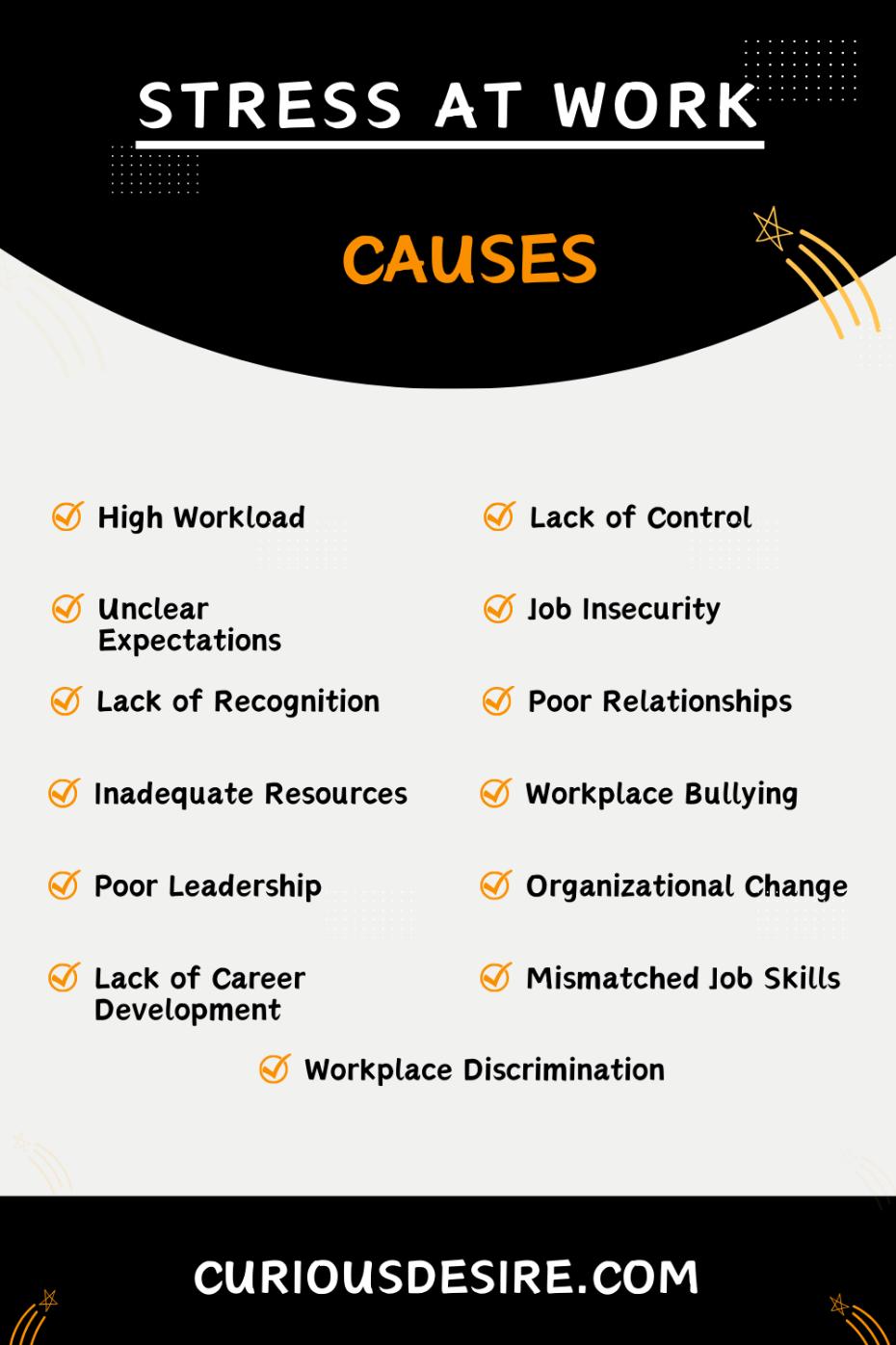Workplace stress is a common challenge affecting many. In our fast-paced work environments, factors like heavy workloads, conflicts, and poor work-life balance contribute significantly.
This guide explores key stressors, providing insights for both employers and employees to cultivate a healthier and more productive workplace.
Here are the top 5 causes of stress at work:
- Lack of Control
- Unclear Expectations
- Poor Relationships at Work
- Inadequate Resources
- Poor Leadership
[toc]

Cause 10: Organizational Change
Big changes at work, like when companies join together, buy each other, or make big changes to how they work, can make employees feel stressed.
Rapid transformations create uncertainty about the future of the company and may leave employees concerned about their roles, responsibilities, and overall job security.
The fear of the unknown, coupled with potential shifts in the organizational culture, can contribute to heightened stress levels.
Effective communication from leadership, transparency about the reasons for the change, and providing support during the transition are crucial to help mitigate stress during times of organizational change.
Cause 11: Lack of Career Development Opportunities
When employees don’t see many chances to grow in their careers, it can make them feel upset and stressed.
If they think they’re not moving forward or if there aren’t many opportunities to get ahead in the company, they might feel like they’re stuck in their current jobs.
This can result in decreased motivation and job satisfaction. Employers can address this by offering training programs, mentorship opportunities, and clear paths for career growth.
Providing avenues for skill development and professional growth can help alleviate stress related to the lack of career advancement.
Cause 12: Mismatched Job Skills and Responsibilities
Being assigned tasks that don’t align with an individual’s skills, qualifications, or interests can result in feelings of inadequacy and stress.
When employees are tasked with responsibilities that do not match their expertise, it can lead to a sense of being overwhelmed.
Ensuring a proper alignment between employees’ skills and their assigned tasks is crucial for job satisfaction.
Clear job descriptions, ongoing training, and regular assessments can help identify and address any mismatches, reducing stress associated with job role incongruence.
Cause 13: Workplace Discrimination
Treating people unfairly at work because of gender, race, age, or ethnicity is a big cause of stress.
When employees go through this, it can make them feel upset, lower their confidence, and make them more anxious.
A workplace that supports diversity and inclusion helps make a positive and helpful environment. This reduces the chances of stress caused by unfair treatment.
Stress At Work Causes FAQs
1. What are the 5 main causes of stress?
The five main causes of stress often include work pressure, financial difficulties, health concerns, major life changes, and relationships.
These factors can vary from person to person, contributing to feelings of anxiety and tension.
2. How do I stop stressing at work?
To alleviate workplace stress, consider effective time management, setting realistic goals, establishing boundaries, seeking support from colleagues or superiors, practicing mindfulness techniques, and ensuring a healthy work-life balance.
Identifying and addressing specific stressors can lead to a more manageable work environment.
3. What are the effects of stress at work?
Work-related stress can lead to physical and mental health issues, such as headaches, fatigue, anxiety, and decreased productivity.
Long-term exposure to stress at work may contribute to burnout and more severe health problems.
4. Which is the most common source of workplace stress?
The most common source of workplace stress often revolves around excessive workload and job demands.
Unrealistic expectations, tight deadlines, and a lack of resources can contribute significantly to employee stress levels.
5. What are the four main types of stress?
The four main types of stress include eustress (positive stress), acute stress, episodic acute stress, and chronic stress.
Each type has distinct characteristics and impacts on an individual’s well-being.
6. Which type of stress is most common?
Chronic stress is often considered the most common type.
It results from prolonged exposure to stressors, such as ongoing financial difficulties or persistent work-related issues, leading to a continuous state of heightened alertness and tension.
7. What is the biggest stress factor?
The biggest stress factor varies among individuals, but common factors include financial concerns, work-related pressures, health issues, and relationship challenges.
Identifying and addressing personal stressors is crucial for effective stress management.
8. What are the 2 main types of stress?
The two main types of stress are acute stress, which is short-term and often results from specific situations, and chronic stress, which is persistent and ongoing.
Both types can impact physical and mental well-being.
9. What is stress and its causes?
Stress is the body’s response to demands or pressures, often triggered by external events or internal thoughts.
Causes of stress can include work demands, major life changes, financial issues, and personal relationships.
10. What are the three main causes of stress?
The three main causes of stress typically involve external pressures, internal conflicts, and major life changes.
These factors can create a sense of imbalance and challenge an individual’s ability to cope effectively.
11. What are common signs of stress?
Common signs of stress encompass physical symptoms like headaches and digestive issues, emotional signs such as irritability and anxiety, and behavioral changes like altered sleep patterns or increased substance use.
12. What are the stages of stress?
Stress often progresses through three stages: the alarm stage (initial response to stressors), the resistance stage (adaptation to ongoing stress), and the exhaustion stage (when the body’s resources are depleted, leading to potential health issues).
13. What are the common sources of stress?
Common sources of stress include work-related pressures, financial challenges, family dynamics, health concerns, and major life events such as moving or changing jobs.
Identifying these stressors is essential for effective stress management.
14. Which is the most common source of workplace stress quizlet?
The most common source of workplace stress, according to various studies, is often linked to factors such as excessive workload, interpersonal conflicts, job insecurity, and a lack of control over work-related decisions.
15. How common is stress in the workplace?
Workplace stress is highly common, affecting a significant portion of the global workforce.
Factors such as job demands, lack of job satisfaction, and poor work-life balance contribute to stress in various professional settings.
16. What is the #1 cause of stress?
The number one cause of stress varies among individuals, but work-related issues, financial concerns, and major life changes are consistently cited as leading stressors.
Identifying and addressing these primary causes is crucial for effective stress management.

